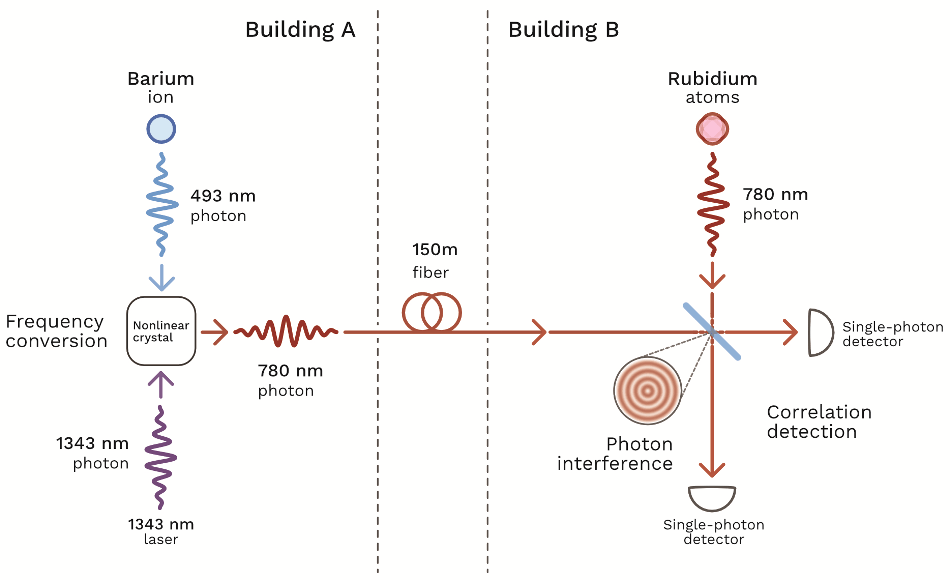Dec 18 2019
At times, particles can behave like waves. This behavior is also applicable to photons, or particles of light.
 Schematic of an interference experiment in which two photons are produced in different buildings, are generated by different sources and have different colors. Image Credit: S. Kelley/National Institute of Standards and Technology.
Schematic of an interference experiment in which two photons are produced in different buildings, are generated by different sources and have different colors. Image Credit: S. Kelley/National Institute of Standards and Technology.
Just like how waves produce an interference pattern—such as ripples on a pond—photons also create a similar pattern.
Physicists at the National Institute of Standards and Technology (NIST), in collaboration with their colleagues, have now accomplished a new, major breakthrough—that is, generating a strange “quantum” interference between two photons with distinctly different colors, emerging from different buildings on the campus of the University of Maryland.
This experiment represents a significant step for quantum computing and quantum communications in the future. Quantum computers can do things that cannot be performed by traditional computers. For example, they can replicate the behavior of new, complex drugs in the body and break strong encryption codes.
Remote quantum processors can be linked by the interference between a pair of photons, resulting in a quantum computer network similar to the internet.
It is vital to use photons that initially had distinct colors or wavelengths because such photons can simulate the working of a quantum computer.
For example, visible-light photons can communicate with trapped ions, atoms, or other systems that act as quantum versions of computer memory, whereas longer-wavelength photons, or near-infrared photons, are capable of propagating over long distances via optical fibers.
Traditional computers require consistent ways to convey, process, and store electrons before complicated, networked computing can be achieved. In a similar way, the exchange of quantum computing data could soon become a reality, thanks to the NIST result.
In the new study, which is a collaboration between the Army Research Laboratory and NIST, engineers and physicists in neighboring buildings at the University of Maryland developed two separate and different sources of individual photons.
In one building, a group of rubidium atoms was induced to release single photons that had a wavelength of 780 nm, toward the red end of the visible light spectrum.
In the other building located 150 m away, a trapped barium ion was prompted to release photons that had a wavelength of 493 nm—almost 40% shorter—at the blue end of the visible light spectrum.
Subsequently, the scientists had to render the blue photons dead ringers for the red photons. To accomplish this feat, Alexander Craddock, Trey Porto, and Steven Rolston from the Joint Quantum Institute—a collaboration between the University of Maryland and NIST—and their colleagues combined the blue photons with infrared light in a unique crystal.
The infrared light was used by the crystal to change the blue photons into a wavelength that corresponds to the red photons in the other building, without compromising on their original characteristics. Only then did the researchers transmit the photons via a 150-m optical fiber to encounter the almost identical red photons present in the other building.
The similarity between the photons was so high that it was impossible to distinguish between them in the experimental setup. Normally, individual photons behave independently of one another.
However, when two indistinguishable photons interfere with one another, their paths can become correlated, or depend on each other. This can be attributed to the strange quantum nature of light. A quantum correlation like that can be utilized as a robust tool for computing.
Indeed, the scientists noticed this association when pairs of the individually produced photons intersected. The photon pairs traveled via an optical component called beamsplitter, which could transmit the photons in either of the two paths.
Each photon acts alone and would do its own thing. The photons would have a 50-50 chance of traveling through either of the two paths.
However, the pair of indistinguishable photons overlapped just like waves. Due to their peculiar quantum interference, they remained together and invariably traveled the same path. This interference combines the once-independent photons at the hip, possibly executing a number of useful tasks in the processing of quantum data.
The scientists have reported their study results online in the latest issue of Physical Review Letters.
Associating the interference pattern to another strange trait of quantum mechanics, called entanglement, would lead to a direct relationship with quantum computing.
Such a phenomenon takes place when two or more particles, including photons, are prepared so that a measurement of a specific trait—for example, momentum—of one particle automatically establishes the same trait of the other, even if the particles are located far apart.
Entanglement forms the core of many schemes of quantum data, including quantum encryption and computing. In the experiment performed by the researchers, the photon pair is not entangled with the systems that created them.
However, in upcoming research, it should be much easy to entangle the red photons with the group of rubidium atoms that generated it, stated Porto.
Likewise, it is possible to entangle the blue photons with the trapped ion that produced them. When interference occurs between the two photons, that connection would transfer the entanglement between the blue photon-ion and the red photon-rubidium atoms to become an entanglement between the trapped ion and the rubidium atoms.
This transfer of entanglement, or transfer of data, underlies the possibly enormous power of quantum computers, stated Porto.